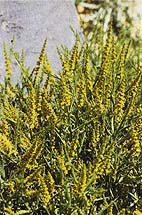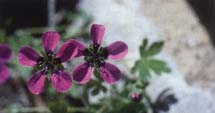OF THE UAE
Text and pictures by Marijcke Jongbloed
People often ask: "What do you do in the desert every week?" And when I tell them that I look for flowers, the next remark is: "But everyone knows there are no plants in the desert!"
 The poppy is not a flower that comes to mind when one thinks of desert flora. Yet, this fragile annual is represented with two species in the hills and mountains of the United Arab Emirates and northern Oman. But do not expect to see the red fields of Flanders - all the temperate climate flowers that do occur in desert areas are few in number and small in size.
The poppy is not a flower that comes to mind when one thinks of desert flora. Yet, this fragile annual is represented with two species in the hills and mountains of the United Arab Emirates and northern Oman. But do not expect to see the red fields of Flanders - all the temperate climate flowers that do occur in desert areas are few in number and small in size.
The red poppy, for instance, is tiny - no more than 1cm in diameter, with the entire plant not reaching more than 15cm. To find a tiny treasure like that in a wadi strewn with enormous boulders is wonderful, it makes my day.
When I started looking at the local flora in the UAE I had no idea that there was such a variety of plants. The plants that grew on sandy soils around Al Ain, where I first lived, were all strange to me. I remember that the first plant I noticed was the desert squash (Citrullus colocynthis) and I did not recognise it as a plant but thought it was a yellow tennis-ball! When I stopped to examine it, I found the younger green-striped fruits and a branch with the beautifully shaped leaves and the yellow flower cups. Close by a stand of Panicum turgidum was in full flower. I would never have noticed the tiny maroon, white and orange flowering grass if I had not had my nose to the ground.
Not true at all. But you do not see them unless you go on foot.
The UAE has over 600 plant species identified, some of which you would certainly not expect to find in arid conditions. The explanation lies in the great variety of habitats to be found in the UAE. Starkly contrasting habitat types can occur very close to each other. Thus, for example, where a watercourse (falaj) winds its way along a rocky hillside, one can find ferns and orchids practically next to cactus-like asclepidiaceae and drought resistant xerophytes. Wadis that look completely dry still have water trapped in various parts of their courses and in these places isolated patches of greenery can disclose interesting weeds.
 A few hundred metres up into the foothills of the high mountains, the slight drop in temperature is already enough to permit growth of some very fragile herbaceous plants. The fields above 1200 metres must have been a sight for rock-sore eyes in the days before goats were kept there! On one memorable visit to northern Oman I discovered a broad, green valley but when I walked into the fields I found that what I had taken for grass turned out to be wild iris plants (Iris sisyrhincus). Unfortunately they had finished flowering. Seen at the right moment, with the iris in full bloom, this valley must look really stunning, so brilliantly blue as if a section of sky has fallen to earth! It was quite obvious that the iris at this site are not being grazed by the goats of the vicinity but they were not so reticent about eating other plants. As a general rule iris is accompanied by gladiolus (Gladiolus italicus), the mountain lily, (Ixiolirion tataricum) and the rare Muscaris longipes., but in the iris field these other species were absent. I noticed however that wherever there were fenced-off areas that the goats could not reach, these other plants were mingled with the iris forming a symphony of brilliant colours.
A few hundred metres up into the foothills of the high mountains, the slight drop in temperature is already enough to permit growth of some very fragile herbaceous plants. The fields above 1200 metres must have been a sight for rock-sore eyes in the days before goats were kept there! On one memorable visit to northern Oman I discovered a broad, green valley but when I walked into the fields I found that what I had taken for grass turned out to be wild iris plants (Iris sisyrhincus). Unfortunately they had finished flowering. Seen at the right moment, with the iris in full bloom, this valley must look really stunning, so brilliantly blue as if a section of sky has fallen to earth! It was quite obvious that the iris at this site are not being grazed by the goats of the vicinity but they were not so reticent about eating other plants. As a general rule iris is accompanied by gladiolus (Gladiolus italicus), the mountain lily, (Ixiolirion tataricum) and the rare Muscaris longipes., but in the iris field these other species were absent. I noticed however that wherever there were fenced-off areas that the goats could not reach, these other plants were mingled with the iris forming a symphony of brilliant colours.
Fragile weeds like vetch (Vicia sativa), bedstraw (Gallium tricorne) and the dark purple poppy Roemeira hibrida mingled with the larger flowers. And on the rocky plains that surrounded the fields, there were Calendula arvensis and the small camomile Anthemis odontostephana, besides the pretty blue pimpernel (Anagallis arvensis), the yellow daisies of Asteriscus pygmaeus and the tiny rock rose Helianthemum salicicornum. In shady corners between the rocks the striking Geranium mascatense grew between tufts of fine ferns. Where the soil was very poor the plants were quite stunted. I found legumes, complete with flowers and fruits of no more than 2cms in diameter. Some plants were covered with common dodder (Cuscuta planifora), an interesting parasitic plant which grows from seed that produces normal seedlings. Once it grows large enough to reach a neighbouring plants with its tendrils it latches on to its new host, losing its own roots, and depends on the host's chlorophyll.
A few of the mountain plants have all the characteristics of desert plants. Various Farsetia species have sparse small foliage to prevent the loss of water. Ochradenus arabicus, a woody perennial, has strong thorns to protect it from being grazed. Carderia draba has thick leaves, covered with a waxy layer that prevents evaporation and reflects the sunlight.
In good years, the two blossoming trees of the mountains are as pretty as any blossom tree in temperate climes. The flowers of the willowy Moringa peregrina perfume the air with their sweet scent. And the Arabian almond (Amygdalus arabicus) looks like a bridal bouquet.
The wood of this almond tree, called "mizzi" in Arabic, provides the mountain tribesmen with the handle for their "yerse", the small axe that they carry for a multiple of purposes, including killing snakes. The tiny almonds are edible and a favourite addition to the local diet.
The extent to which the mountain flora suffers from the onslaught of grazing goats can be seen wherever a small garden is protected from them by fencing. Inside the fence lush vegetation stands knee high, while outside everything that grows is cropped right down to the roots. Given that goats often pull out entire plants, roots and all, makes one wonder just how much of the mountains' natural flora has been lost due to grazing. It seems clear that a large nature reserve in the Musandam and Hajar mountains would be beneficial, not only to those animals that need our protection, but also to the region's unique floral assemblage.
| Subjects | Search
Arabian Wildlife. Volume 1, Number 2